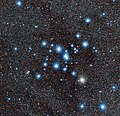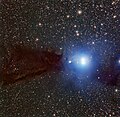
The Very Large Telescope (VLT) is a facility operated by the European Southern Observatory, located on Cerro Paranal in the Atacama Desert of northern Chile. It consists of four individual telescopes, each equipped with a primary mirror that measures 8.2 meters in diameter. These optical telescopes, named Antu, Kueyen, Melipal, and Yepun, are generally used separately but can be combined to achieve a very high angular resolution. The VLT array is also complemented by four movable Auxiliary Telescopes (ATs) with 1.8-meter apertures.

The European Organisation for Astronomical Research in the Southern Hemisphere, commonly referred to as the European Southern Observatory (ESO), is an intergovernmental research organisation made up of 16 member states for ground-based astronomy. Created in 1962, ESO has provided astronomers with state-of-the-art research facilities and access to the southern sky. The organisation employs over 750 staff members and receives annual member state contributions of approximately €162 million. Its observatories are located in northern Chile.

The Eagle Nebula is a young open cluster of stars in the constellation Serpens, discovered by Jean-Philippe de Cheseaux in 1745–46. Both the "Eagle" and the "Star Queen" refer to visual impressions of the dark silhouette near the center of the nebula, an area made famous as the "Pillars of Creation" imaged by the Hubble Space Telescope. The nebula contains several active star-forming gas and dust regions, including the aforementioned Pillars of Creation. The Eagle Nebula lies in the Sagittarius Arm of the Milky Way.

Messier 107 or M107, also known as NGC 6171 or the Crucifix Cluster, is a very loose globular cluster in a very mildly southern part of the sky close to the equator in Ophiuchus, and is the last such object in the Messier Catalogue.

The VLT Survey Telescope (VST) is a telescope located at ESO's Paranal Observatory in the Atacama Desert of northern Chile. It is housed in an enclosure immediately adjacent to the four Very Large Telescope (VLT) Unit Telescopes on the summit of Cerro Paranal. The VST is a wide-field survey telescope with a field of view twice as broad as the full Moon. It is the largest telescope in the world designed to exclusively survey the sky in visible light.
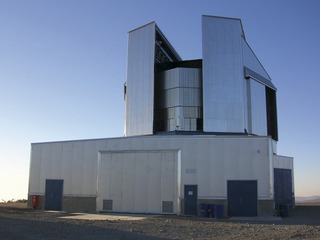
The VISTA is a wide-field reflecting telescope with a 4.1 metre mirror, located at the Paranal Observatory in Chile. It is operated by the European Southern Observatory and started science operations in December 2009. VISTA was conceived and developed by a consortium of universities in the United Kingdom led by Queen Mary University of London and became an in-kind contribution to ESO as part of the UK's accession agreement, with the subscription paid by the UK Science and Technology Facilities Council (STFC).
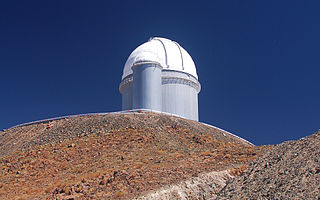
The ESO 3.6 m Telescope is an optical reflecting telescope run by the European Southern Observatory at La Silla Observatory, Chile since 1977, with a clear aperture of about 3.6 metres (140 in) and 8.6 m2 (93 sq ft) area.

Messier 47 is an open cluster in the mildly southern constellation of Puppis. It was discovered by Giovanni Batista Hodierna before 1654 and in his then keynote work re-discovered by Charles Messier on 1771. It was also independently discovered by Caroline Herschel.

La Silla Observatory is an astronomical observatory in Chile with three telescopes built and operated by the European Southern Observatory (ESO). Several other telescopes are located at the site and are partly maintained by ESO. The observatory is one of the largest in the Southern Hemisphere and was the first in Chile to be used by ESO.

Paranal Observatory is an astronomical observatory operated by the European Southern Observatory (ESO). It is located in the Atacama Desert of Northern Chile on Cerro Paranal at 2,635 m (8,645 ft) altitude, 120 km (70 mi) south of Antofagasta. By total light-collecting area, it is the largest optical-infrared observatory in the Southern Hemisphere; worldwide, it is second to the Mauna Kea Observatory on Hawaii.

NGC 246 is a planetary nebula in the constellation Cetus. It is the first known planetary nebula to have a hierarchical triple star system at its center. The nebula and the stars associated with it are listed in several catalogs, as summarized by the SIMBAD database. NGC 246 was discovered by William Herschel in 1785.
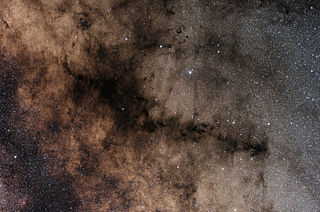
The Pipe Nebula is a dark nebula in the Ophiuchus constellation and a part of the Dark Horse Nebula. It is a large but readily apparent smoking pipe-shaped dust lane that obscures the Milky Way star clouds behind it. Clearly visible to the naked eye in the Southern United States under clear dark skies, but it is best viewed with 7× binoculars.

NGC 3201 is a low galactic latitude globular cluster in the southern constellation of Vela. It has a very low central concentration of stars. This cluster was discovered by James Dunlop on May 28, 1826 and listed in his 1827 catalogue. He described it as "a pretty large pretty bright round nebula, 4′ or 5′ diameter, very gradually condensed towards the centre, easily resolved into stars; the figure is rather irregular, and the stars are considerably scattered on the south".
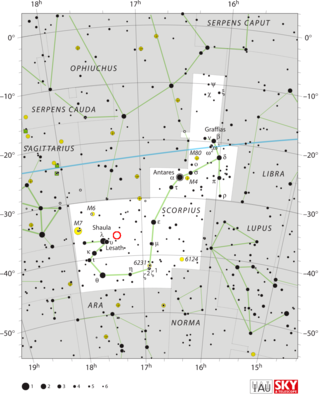
NGC 6334, colloquially known as the Cat's Paw Nebula, or Gum 64, is an emission nebula and star-forming region located in the constellation Scorpius. NGC 6334 was discovered by astronomer John Herschel in 1837, who observed it from the Cape of Good Hope in South Africa. The nebula is located in the Carina–Sagittarius Arm of the Milky Way, at a distance of approximately 5.5 kilolight-years from the Sun.

NGC 6752 is a globular cluster in the constellation Pavo. It is the fourth-brightest globular cluster in the sky, after Omega Centauri, 47 Tucanae and Messier 22, respectively. It is best seen from June to October in the Southern Hemisphere.

The Gamma-Ray Burst Optical/Near-Infrared Detector (GROND) is an imaging instrument used to investigate Gamma-Ray Burst afterglows and for doing follow-up observations on exoplanets using transit photometry. It is operated at the 2.2-metre MPG/ESO telescope at ESO's La Silla Observatory in the southern part of the Atacama desert, about 600 kilometres north of Santiago de Chile and at an altitude of 2,400 metres.
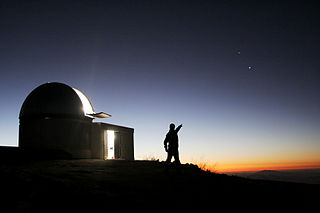
The Transiting Planets and Planetesimals Small Telescope (TRAPPIST) is the corporate name for a pair of Belgian optic robotic telescopes. TRAPPIST–South, which is situated high in the Chilean mountains at ESO's La Silla Observatory, came online in 2010, and TRAPPIST–North situated at the Oukaïmeden Observatory in the Atlas Mountains in Morocco, came online in 2016.
HIP 13044 is a red horizontal-branch star about 2,300 light years from Earth in the constellation Fornax. The star is part of the Helmi stream, a former dwarf galaxy that merged with the Milky Way between six and nine billion years ago. As a result, HIP 13044 circles the Galactic Center at a highly irregular orbit with respect to the galactic plane. HIP 13044 is slightly less massive than the Sun, but is approximately seven times its size. The star, which is estimated to be at least nine billion years old, has passed the red-giant phase. The relatively fast rotation of the star may be due to having engulfed one or more planets during the red-giant phase.

The Swedish-ESO Submillimetre Telescope (SEST) is a 15-metre diameter radio telescope. It was originally located at the La Silla Observatory in Chile, and will be moved to Africa and repurposed as the Africa Millimetre Telescope.
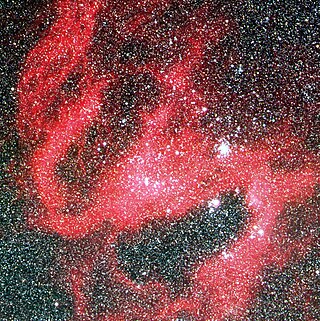
N119 is a spiral-shaped H II region in the Large Magellanic Cloud. Its dimensions are large, at 131 x 175 pc. It contains several luminous stars including S Doradus, LH41-1042, and LMC195-1. Its peculiar S-shaped structure is difficult to explain with classical models.


